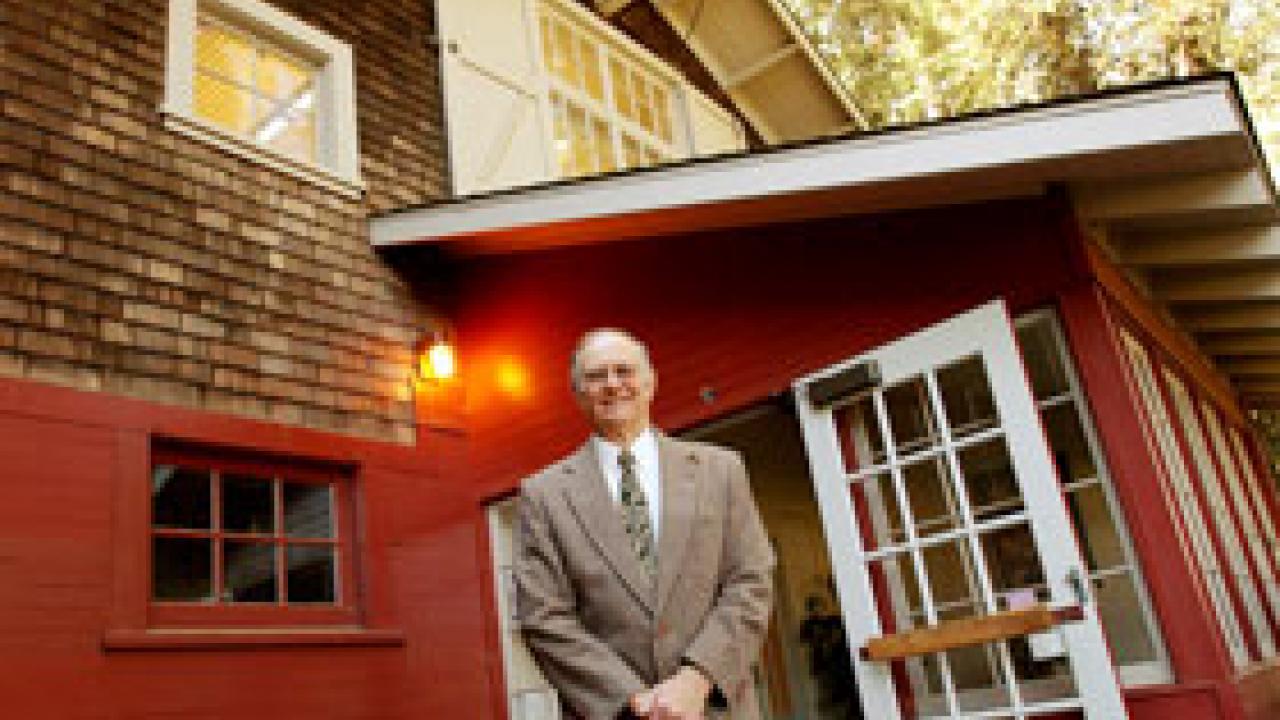John Muir would be proud. The UC Davis institute bearing the name of the renowned conservationist has evolved into a community of programs investigating environmental issues in a wide range of disciplines such as ecotoxicology, watershed management, aquatic and terrestrial ecology, natural resources policy, and a comparatively new frontier, road ecology.
The John Muir Institute of the Environment (JMIE) is celebrating its seventh year with a recent move into a centralized location on prime campus real estate -- the historic horse barn near the Silo that was home to Architects and Engineers for many years.
"One of our objectives is to elevate our visibility," said Dennis Rolston, the institute's director and a professor of soil science in the Department of Land, Air and Water Resources. "We also wanted to bring people together physically under one roof to increase interaction that will foster more interdisciplinary research on the environment."
The "Jimmy," as staffers affectionately call the institute, is an organized research unit that administers more than $12 million in extramural grants from many state and federal agencies and foundations. What distinguishes the institute is its focus on interdisciplinary research to help public policymakers make sound decisions on environmental issues. An advisory committee, currently composed of faculty members from nine different schools and departments, guides the institute.
The idea for the institute was first discussed in the early 1990s, when Chancellor Ted Hullar challenged campus faculty to create an innovative research entity to promote interdisciplinary environmental research, teaching and outreach, Rolston recalls. An unfavorable budget climate delayed its creation until 1997, when the John Muir Institute of the Environment cleared UC's statewide Academic Senate. The institute is now home to about a dozen different centers and programs.
Partnering and shaping policy
One of the institute's most recent major accomplishments was the creation of the Tahoe Environmental Research Center and selection of its founding director, Geoffrey Schladow, a UC Davis professor of civil and environmental engineering. Rolston and his staff helped broker a partnership with Sierra Nevada College to build new teaching and research facilities at Tahoe's north shore next year.
The institute sponsors six $18,000 fellowships for UC Davis graduate students involved in environmental scholarship. The fellowships are awarded to those who propose the most helpful projects for policy makers and resource professionals.
Among current projects are a study of the effects of watershed restoration on mercury levels in fish; development of a GIS database of geology, plant communities and other environmental factors affecting the rare island oak; and creation of an economic computer model to help China deregulate its timber industry.
The institute also helps fund a variety of campus workshops, seminars, conferences and special speakers, such as the graduate group series "The New Geography of California Water"; a seminar series on cold-water fish; the Sierra Nevada Symposium at Lake Tahoe; and a painting workshop by Pablo D'Amarino, an indigenous Amazonian environmental artist.
Reaching out to humanities
Last year the institute sponsored "Rivers and Tides," a well-received movie about Scottish land artist Andy Goldsworthy. And on Nov. 5 the institute is bringing Telluride's annual MountainFilm to the Varsity Theater in Davis. The event features film and videos with mountain, adventure, cultural and environmental themes.
"Part of our mission is to reach across all disciplines, including the humanities," said Cheryl Smith, the institute's assistant director. "Sociologists and humanists need to be brought into the discussion on environmental concerns and solutions."
Graduate school proposed
Next on the horizon is the formation of a Graduate School of the Environment, which would draw expertise from throughout the campus, including agriculture, biology, engineering, geology, humanities, law, policy, management and veterinary medicine. The school would eventually subsume the John Muir Institute of the Environment as its research arm. At the heart of the graduate-school curriculum would be a high-profile, prestigious master's degree program in environmental policy and management modeled on those offered by the John F. Kennedy School of Government at Harvard and the Woodrow Wilson School of Public and International Affairs at Princeton.
"This is truly a grassroots effort driven by our faculty to engage a broader cross-section of people in different areas of environmental scholarship," Rolston said. "In order to solve environmental problems, it has to be done with an interdisciplinary team of people."
Rolston hopes the proposal, currently under review by the Academic Senate, becomes a reality in the next year or two. Information on the proposed graduate school, including links to academic and organizational plans, is available online at http://gse.ucdavis.edu/.
"We don't want to miss our window of opportunity with this graduate school," Rolston said. "We have more faculty involved in environmental research than anywhere else in the country. We should be the leaders in advancing new approaches to environmental scholarship."
Media Resources
John Stumbos, (530) 754-2261, jdstumbos@ucdavis.edu
